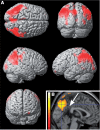The neurobiology of glucocerebrosidase-associated parkinsonism: a positron emission tomography study of dopamine synthesis and regional cerebral blood flow
- PMID: 22843412
- PMCID: PMC3407426
- DOI: 10.1093/brain/aws174
The neurobiology of glucocerebrosidase-associated parkinsonism: a positron emission tomography study of dopamine synthesis and regional cerebral blood flow
Abstract
Mutations in GBA, the gene encoding glucocerebrosidase, the enzyme deficient in Gaucher disease, are common risk factors for Parkinson disease, as patients with Parkinson disease are over five times more likely to carry GBA mutations than healthy controls. Patients with GBA mutations generally have an earlier onset of Parkinson disease and more cognitive impairment than those without GBA mutations. We investigated whether GBA mutations alter the neurobiology of Parkinson disease, studying brain dopamine synthesis and resting regional cerebral blood flow in 107 subjects (38 women, 69 men). We measured dopamine synthesis with (18)F-fluorodopa positron emission tomography, and resting regional cerebral blood flow with H(2)(15)O positron emission tomography in the wakeful, resting state in four study groups: (i) patients with Parkinson disease and Gaucher disease (n = 7, average age = 56.6 ± 9.2 years); (ii) patients with Parkinson disease without GBA mutations (n = 11, 62.1 ± 7.1 years); (iii) patients with Gaucher disease without parkinsonism, but with a family history of Parkinson disease (n = 14, 52.6 ± 12.4 years); and (iv) healthy GBA-mutation carriers with a family history of Parkinson disease (n = 7, 50.1 ± 18 years). We compared each study group with a matched control group. Data were analysed with region of interest and voxel-based methods. Disease duration and Parkinson disease functional and staging scores were similar in the two groups with parkinsonism, as was striatal dopamine synthesis: both had greatest loss in the caudal striatum (putamen Ki loss: 44 and 42%, respectively), with less reduction in the caudate (20 and 18% loss). However, the group with both Parkinson and Gaucher diseases showed decreased resting regional cerebral blood flow in the lateral parieto-occipital association cortex and precuneus bilaterally. Furthermore, two subjects with Gaucher disease without parkinsonian manifestations showed diminished striatal dopamine. In conclusion, the pattern of dopamine loss in patients with both Parkinson and Gaucher disease was similar to sporadic Parkinson disease, indicating comparable damage in midbrain neurons. However, H(2)(15)O positron emission tomography studies indicated that these subjects have decreased resting activity in a pattern characteristic of diffuse Lewy body disease. These findings provide insight into the pathophysiology of GBA-associated parkinsonism.
Figures



Similar articles
-
Functional brain imaging in glucocerebrosidase mutation carriers with and without parkinsonism.Mov Disord. 2010 Sep 15;25(12):1823-9. doi: 10.1002/mds.23213. Mov Disord. 2010. PMID: 20669267
-
The spectrum of parkinsonian manifestations associated with glucocerebrosidase mutations.Arch Neurol. 2008 Oct;65(10):1353-7. doi: 10.1001/archneur.65.10.1353. Arch Neurol. 2008. PMID: 18852351 Free PMC article.
-
Transcranial sonography and functional imaging in glucocerebrosidase mutation Parkinson disease.Parkinsonism Relat Disord. 2013 Feb;19(2):186-91. doi: 10.1016/j.parkreldis.2012.09.007. Epub 2012 Oct 10. Parkinsonism Relat Disord. 2013. PMID: 23062841 Free PMC article.
-
The association between mutations in the lysosomal protein glucocerebrosidase and parkinsonism.Mov Disord. 2009 Aug 15;24(11):1571-8. doi: 10.1002/mds.22538. Mov Disord. 2009. PMID: 19425057 Free PMC article. Review.
-
The association between ß-glucocerebrosidase mutations and parkinsonism.Curr Neurol Neurosci Rep. 2013 Aug;13(8):368. doi: 10.1007/s11910-013-0368-x. Curr Neurol Neurosci Rep. 2013. PMID: 23812893 Free PMC article. Review.
Cited by
-
Lewy body disease or diseases with Lewy bodies?NPJ Parkinsons Dis. 2022 Jan 10;8(1):3. doi: 10.1038/s41531-021-00273-9. NPJ Parkinsons Dis. 2022. PMID: 35013341 Free PMC article. Review.
-
Gaucher disease: insights from a rare Mendelian disorder.Discov Med. 2012 Oct;14(77):273-81. Discov Med. 2012. PMID: 23114583 Free PMC article. Review.
-
Deficient vesicular storage: A common theme in catecholaminergic neurodegeneration.Parkinsonism Relat Disord. 2015 Sep;21(9):1013-22. doi: 10.1016/j.parkreldis.2015.07.009. Epub 2015 Jul 17. Parkinsonism Relat Disord. 2015. PMID: 26255205 Free PMC article.
-
Parkinsonisms and Glucocerebrosidase Deficiency: A Comprehensive Review for Molecular and Cellular Mechanism of Glucocerebrosidase Deficiency.Brain Sci. 2019 Feb 1;9(2):30. doi: 10.3390/brainsci9020030. Brain Sci. 2019. PMID: 30717266 Free PMC article. Review.
-
Glucocerebrosidase and Parkinson disease: Recent advances.Mol Cell Neurosci. 2015 May;66(Pt A):37-42. doi: 10.1016/j.mcn.2015.03.013. Epub 2015 Mar 20. Mol Cell Neurosci. 2015. PMID: 25802027 Free PMC article. Review.
References
-
- Bharucha NE, Stokes L, Schoenberg BS, Ward C, Ince S, Nutt JG, et al. A case-control study of twin pairs discordant for Parkinson disease: a search for environmental risk factors. Neurology. 1986;36:284–8. - PubMed
-
- Brockmann K, Srulijes K, Hauser AK, Schulte C, Csoti I, Gasser T, et al. GBA-associated PD presents with nonmotor characteristics. Neurology. 2011;77:276–80. - PubMed
-
- Elbaz A, Bower JH, Maraganore DM, McDonnell SK, Peterson BJ, Ahlskog JE, et al. Risk tables for parkinsonism and Parkinson disease. J Clin Epidemiol. 2002;55:25–31. - PubMed

